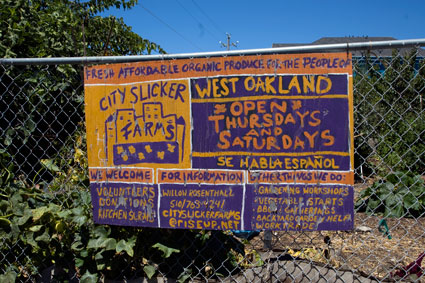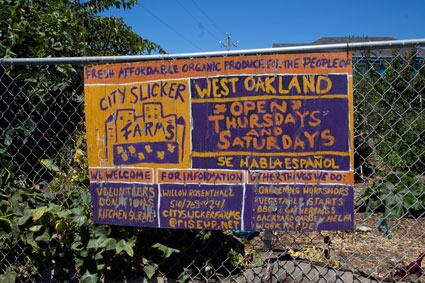 City Slicker Farms in West Oakland does more than just grow food for the local residents.(Bonnie Powell photo)Over on Earth Island Journal, Sena Christian has an excellent, rigorously reported article about the tough economics of urban farming. She focuses on some of the more famous city farms of the Bay Area, where EIJ is based — City Slicker Farms, People’s Grocery — but she also discusses projects like Milwaukee’s Growing Power. And she finishes the piece with a farm I’d never heard of before: Greensgrow, in Philadelphia.
City Slicker Farms in West Oakland does more than just grow food for the local residents.(Bonnie Powell photo)Over on Earth Island Journal, Sena Christian has an excellent, rigorously reported article about the tough economics of urban farming. She focuses on some of the more famous city farms of the Bay Area, where EIJ is based — City Slicker Farms, People’s Grocery — but she also discusses projects like Milwaukee’s Growing Power. And she finishes the piece with a farm I’d never heard of before: Greensgrow, in Philadelphia.
Acknowledging the limits of urban ag, Christian seeks to tease out its potential: particularly its economic upside. Limits are an important place to start on this topic. For all the hype urban farms have gotten of late, no one who works in the field expects cities to become anything close to self-sufficient with regard to food. Any realistic vision of “green cities” sees them as consumption hubs in a larger regional foodshed: dense population centers surrounded not by sprawling suburbs, but rather by diversified farms of a multiplicity of scales.
Urban plots can fill in gaps — putting into action the insight, proven in 19th century France and other places, that small spaces, fortified with lots of rich, composted food waste, can be highly productive. (Probably the greatest U.S. proponent of French-intensive, also called “biointensive,” gardening is John Jeavons.) Specifically, urban farms can turn food production into a source of jobs and fresh food in depressed areas that lack access to both.
Yet the task isn’t easy. Christian’s piece hangs on the following premise:
[U]rban farming’s potential to address the challenges of our food system remains unclear. Although popularity and trendiness can be big boons to business, these urban farms haven’t yet found a way to thrive in the market economy. Most rely heavily on volunteer labor and grant funding. They may be at the forefront of ecological sustainability, but economic sustainability eludes them. And that’s a problem because they are unlikely to fulfill their aspirations and make a meaningful dent in the problem of food insecurity if they are forever running on the treadmill of foundation funding.
These are extremely important points, and Christian does some valuable reporting to bolster them. It’s true, as she points out, that most of our most visible and effective urban farm projects were launched with foundation cash and still rely on it to operate. Probably the most celebrated project, Milwaukee’s Growing Power, has received “at least $1 million in grants” over the past five years, Christian reports.
But there’s some missing context here: all farms struggle mightily to “thrive in a market economy” — and relatively few actually do. The most obvious evidence to back up this point is commodity subsidies. If any farm type should be able to thrive in the free market, it would be the large corn and soy farms of the Midwest. They stand on one of the world’s greatest stores of topsoil; they are highly capitalized, with towering combines tricked out with GPS and other technology that allow a single farmer to cover thousands of acres. They have have access to high-tech seeds and bottomless amounts of fertilizer and pesticides. Agribusiness giants like ADM and Cargill have built up an elaborate infrastructure to buy their goods and ship them around the globe.
Yet over most of the past 20 years, corn and soy prices have hovered under the cost of production, making these farms reliant on billions of dollars in annual subsidies to stay solvent. They’ve turned marginally profitable over the past few years — not due to the magic of the free market, however, but because a government-mandated and -subsidized ethanol program has lifted corn and soy prices. Like urban farms, “economic sustainability eludes them.” They are wards not of the foundations, but rather of the state.
Another way to put the economic struggles of urban farms in a broader context is to look at USDA farm-income data. Time for a bracing dip into the Farm Household Economics and Well-Being page, kept up by the USDA’s Economic Research Service! (As this vintage 2006 post will show, I’ve long enjoyed such forays into data nerd-dom.)
The nut from the ERS’s latest findings: In 2010, the average family farm is forecast to receive 10.3 percent of its household income from farm sources, with the rest from earned and unearned off-farm income. Farm income is forecast to average $8,338. The average off-farm income is forecast to be $72,428.
Not much green in them there fields.
OK, so those extremely depressing numbers aggregate all farms: from hobby operations claiming farm status for a tax break to Midwestern mega-farms. So let’s drill down by farm size. (See chart, right.) For farms that bring in between $10,000 and $249,000 in gross sales, farm income represents a tiny fraction of farm families’ overall earnings (see green sliver in middle bar). This category encompasses the non-hobby, small- and mid-sized farms that supply the bulk of produce at farmers markets. After farm expenses, these farm families bring home about $60,000 in annual income, a very small slice of which comes from farm profits. These farms, too, are subsidized — not by the government, but rather by the off-farm income of farmers and their spouses.
My point is that teasing a living from the earth is extremely difficult. People make it work for all manner of reasons; maximizing personal income is rarely one of them. There’s a passage in Richard Manning’s 2004 book, Against the Grain, that puts it well:
A farm scholar once asked an agribusiness executive when his corporation would simply take over the farms. The exec said that it would be dumb for the corporation to do so, in that it is not free to exploit its employees to the degree that farmers are willing to exploit themselves.
On a happier note, farms produce more than food for consumers and money for farmers. To employ a phrase from economics, they are multifunctional: they produce food, yes, but also environmental goods like healthy soil (or damages like depleted soil and polluted waterways); open, pretty spaces for the public (or public nuisances, as in the case of factory-scale animal farms). The problem is that they only get paid for the food — and not nearly enough, many people now agree.
The farms profiled by Christian provide significant positive goods for which the market doesn’t compensate them: interesting, learning-oriented jobs for teens who would otherwise be consigned to the fast-food or narcotics trades; high-quality produce in low-income neighborhoods with limited food access; open public spaces in neighborhoods that lack parks; community organizing opportunities; a mechanism through which food expenditures can circulate within communities, building wealth; and more.
It makes sense that foundations are filling a void that markets can’t. And once urban farms have their farming systems down and sufficient infrastructure in place, I suspect many of them will some day be profitable, if not exactly lucrative. Christian reports that Philly’s Greensgrow now operates in the black, after years of foundation support. I suspect that Milwaukee’s highly productive Growing Power, if it dropped its educational efforts and just marketed food, could too.
But if we wait for the magic of the market to solve inner-city food problems, I fear we’ll be left hungry for change.




